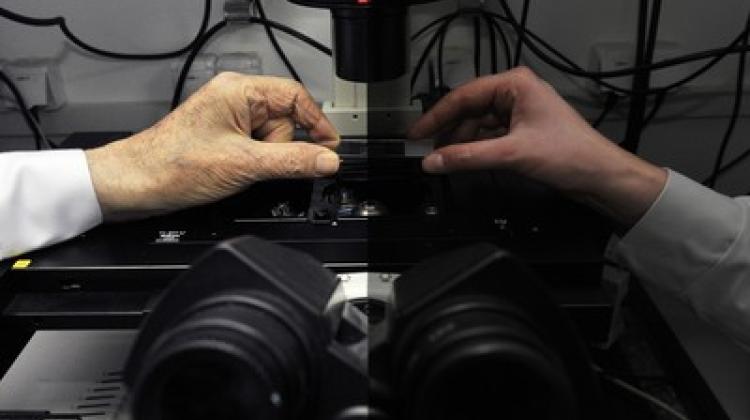Scientists know how to extend the life of the molecules killed by light
 The photostability of chemical molecules suspended in a polymer can be enhanced by limiting their contact with oxygen, as found by researchers from the Institute of Physical Chemistry of the Polish Academy of Sciences (IPC PAS) in Warsaw, Poland. (Source: IPC PAS, Grzegorz Krzyżewski)
The photostability of chemical molecules suspended in a polymer can be enhanced by limiting their contact with oxygen, as found by researchers from the Institute of Physical Chemistry of the Polish Academy of Sciences (IPC PAS) in Warsaw, Poland. (Source: IPC PAS, Grzegorz Krzyżewski)
Lifetime of molecules that interact strongly with light is generally very short, which, for example, makes it difficult for researchers to carry out certain tests and causes paint fading on recently painted walls. Researchers from the IPC PAS have found reasons for their quick death, which will allow to significantly improve the photostability of molecules.
Vivid colours of recently painted walls fade quickly, and in a lab chemical molecules illuminated with laser disintegrate too quickly, making it difficult to conduct measurements. In these cases, the factor responsible for the disintegration of particles is light. The time of disintegration can now be significantly extended - thanks to the research of a group of scientists from the Institute of Physical Chemistry of the Polish Academy of Sciences (IPC PAS) in Warsaw, headed by Prof. Jacek Waluk. The researchers were able to identify the main mechanism that accelerates photodestruction of chemical molecules.
The results of the group from the IPC PAS, obtained in a study funded with a grant from the National Science Centre, have broad practical significance. Used in laboratories, they will increase the possibilities for the studying individual chemical molecules with fluorescent methods, which was a major challenge for over 20 years. Understanding the mechanism of photodestruction of molecules is also useful wherever objects are produced with use of polymers and dyes. Selection of suitable polymers that hinder the migration of oxygen - key in the photodestruction process - may in fact significantly extend the life of dyes and consequently the products.
"In our lab we observe single chemical molecules. We do it under a fluorescence microscope and examine the light they emit. The main problem here is the lifetime of the particles: even those considered stable disintegrate after a few to a dozen seconds. So we decided to extend their life" - said Prof. Waluk, one of the authors of a paper published in the "Journal of Physical Chemistry Letters".
As reported in the IPC PAS release sent to PAP, the key to extending the photostability of molecules was the analysis of the method of preparation for observation under a fluorescence microscope. The procedure starts with the preparation of a dilute solution of the molecules in dissolved polymer. "A solution droplet is then placed on a microscope slide located on a rotating disk. As a consequence of rotation, droplet spreads over the surface, and the solvent evaporates. A thin polymer layer with thickness of only 30 nm remains on the slide, with trapped individual particles of the test substance, which are about the size of a nanometer. If the concentration of particles in the initial solution has been appropriately selected, single test molecules will be positioned in the polymer layer at relatively large distances from each other, on the order of microns (if people were positioned with similar density, the nearest neighbours would be several kilometres away from each other)"- reported IPC PAS.
Prepared slide - reads the release - is placed under the microscope, where the polymer layer is illuminated with a narrow laser beam with light wave energy adjusted to excite the test molecules. If fluorescence appears, it most likely originates from a single molecule of the test compound.
With what may the excited molecule react? The primary suspected from the beginning was oxygen, which can be dissolved in polymer solutions. The researchers therefore examined the effects of seven polymers on the life of - tested at the Institute - TDI (terylene diimide) molecules, but did not detect a link between better oxygen dissolution and accelerated photodestruction of TDI. The correlation appeared only when they looked at the effect of the oxygen permeation rate through a polymer. Here the differences were significant: polymers, through which oxygen permeated slowly, clearly extended the photostability of molecules. A record polymer - it turned out to be a popular polyvinyl chloride - could increase the life of molecules even a hundred times. There was also a lengthening of the time with the age of polymer. It was another argument for the crucial role of oxygen, since it is known that oxygen penetrates older polymers more slowly.
"We are convinced that it is not only the reaction of molecules with light that is responsible for the accelerated photodestruction of our molecules, but also their reaction with oxygen. The excited molecule passes into what is technically known as a triplet state. In this state triplet oxygen in the basic state can combine with it. The oxygen is activated and passes into singlet state, and singlet oxygen is an extremely voracious chemical individual, instantly forming reactions with anything that is within its reach"- explained Prof. Waluk.
PAP - Science and Scholarship in Poland
ekr/ mrt/
tr. RL
Przed dodaniem komentarza prosimy o zapoznanie z Regulaminem forum serwisu Nauka w Polsce.


















